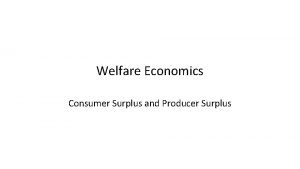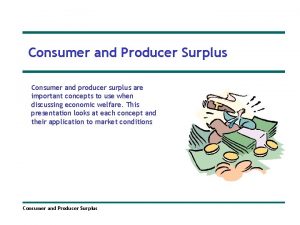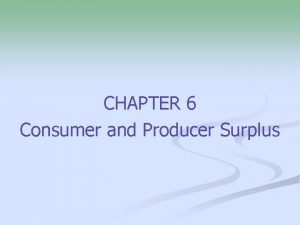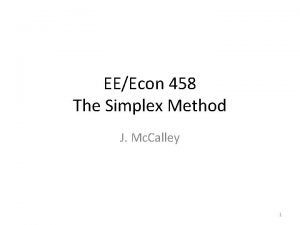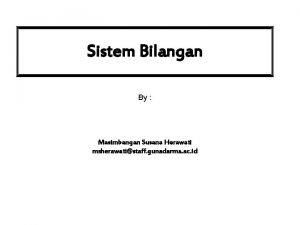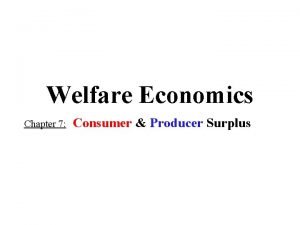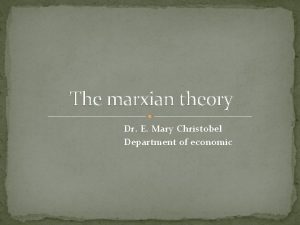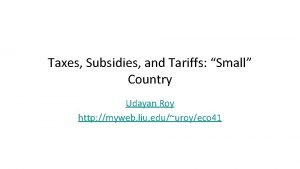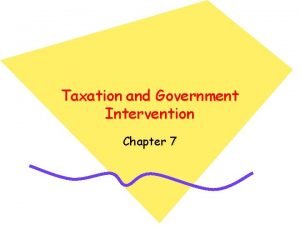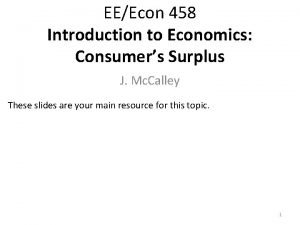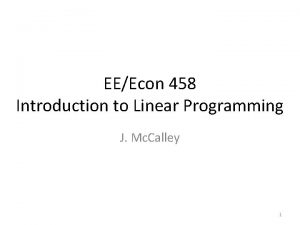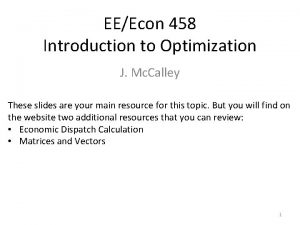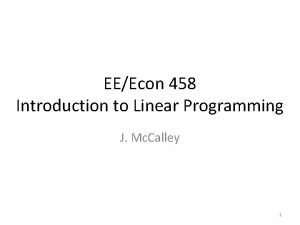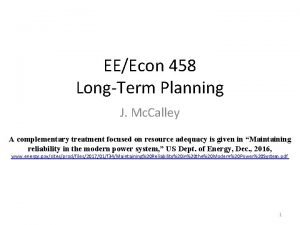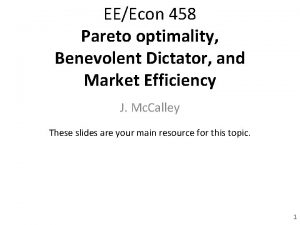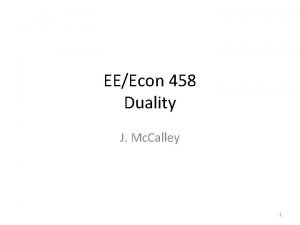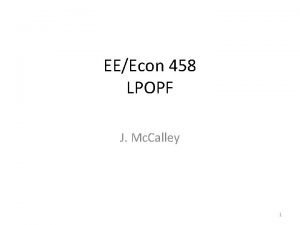EEEcon 458 Introduction to Economics Producers Surplus J


















- Slides: 18

EE/Econ 458 Introduction to Economics: Producer’s Surplus J. Mc. Calley These slides are your main resource for this topic. 1

Supply functions and Producer Surplus An supply curve characterizes the manner in which the supply of a good will change as its price changes, holding constant all other factors that influence producers’ willingness or ability to pay for the good. This characteristic is called the Supply increases as price increases (or supply decreases as price decreases). inverse supply function. Inverting it gives us the supply function. When supply changes with price, we say the supply is elastic. 2

Supply functions and Producer Surplus In early market designs, previous to ~2013, wind plants did not participate in the market; they generated as much as the wind dictated, and they were paid the clearing price. This illustrates an inelastic supply, i. e. , a supply that is price insensitive. But most electricity producers behave elastically (today, wind participates in the market behaving more elastically). 3

Supply functions and Producer Surplus Consider a suppliers w/ following behavior: • below 20 $/MWhr, they shut down their power plant. • at 20 $/MWhr, they produce, supplying up to 4 MWhrs; • if price goes to 30 $/MWhr, they produce up to 7 MWhrs; • if price goes to 50 $/MWhr, they produce up to 50 MWhrs. 4

Supply functions and Producer Surplus Consider that we have the hourly cost function for a producer C as a function of the amount it produces P. Two cautions: 1. Make sure to distinguish price p from production P. 2. We will assume that C to be in $/MWhr and P to be MW for one hour (MWhr). We assume C to be convex (we will be maximizing –C equivalent to minimizing C). C(P) x 5

Supply functions and Producer Surplus The value C(P) is the amount of money the producer needs to spend in order to produce P MWhrs. And we know its derivative C’, the incremental cost, or, the marginal cost of energy. The producer faces an energy price of p and needs to find the production level which maximizes profits. Profits are given by the amount the producer is paid for producing P MWhr less the amount it costs the producer to produce P MWhr. The amount the producer is paid when the price is p. P. So profits are given by p. P-C(P). In contrast to the consumer’s resource (money), the producer’s resource is energy, P. Whereas the consumer had a constraint on money, the producer has a constraint on energy. That constraint is 0<P<Pmax. 6

Supply functions and Producer Surplus So producer needs to solve the following optimization problem: (1) In our approach to inequality constrained optimization problems, we first solve the unconstrained problem and then check our solution. Following this approach, we apply first order conditions to the expression inside the curly brackets to obtain: (2) Implication? When the producer sees price p, s/he should produce the amount of energy P which results in (3) 7

Supply functions and Producer Surplus When the producer sees price p, s/he should produce the amount of energy P which results in (3) What does this tell us? . . . Recall that C’(P) expresses the marginal cost for the amount of energy we buy, P. That is, the marginal cost of energy should be equal to the price of energy in order for the producer to maximize profits. One can also interpret (3) as the inverse supply function: for each possible quantity P, it gives us the market price of energy p that would induce the producer to sell exactly P. 8

Supply functions and Producer Surplus Definition: The inverse supply function, p=C’(P), expresses price as a function of supply. Definition: The demand function, P(p), expresses supply as a function of price. Example 1: Let Find the inverse supply function and the supply function. And so the inverse supply function is: And the supply function is found by solving for P: The two functions are plotted on the next slide… 9

Supply functions and Producer Surplus Inverse supply function Supply function 10

Supply functions and Producer Surplus Question: Consider that the producer has a choice of participating in the electric energy market or not. Will it benefit by doing so? Answer: It depends… on what? On the difference between • the producer’s total profits when it participates and • its total profits when it does not. If it does participate, and the energy price is p, then it produces P, it gets paid p. P, and it incurs a cost C(P) If it does not participate, then it produces 0, it gets paid 0, and it incurs a cost C(0) . The producer’s surplus is: (4) By Fundamental Theorem of Calculus 11

Supply functions and Producer Surplus (4) Equation (4) has a nice graphical interpretation illustrated below, where we assume a price p* results in a supply P*. • The first term of (4) corresponds to the total “box, ” shaded by vertical lines, lower side 0: P* and left-hand-side 0: p*. • The second term of (4) corresponds to the area under the p=C’(x) curve from 0 to P*, which is the area shaded by horizontal 12 lines.

Supply functions and Producer Surplus Question: Suppose the price of energy is increased from p 0 to p 1. What happens to the producer’s surplus? That is, does price increase cause PS to increase or decrease, and by how much? How to think about answering this question…. ? 1. Get the producer’s surplus at p 0, PS(p 0), assuming P 0 2. Get the producer’s surplus at p 1, PS(p 1), assuming P 1 3. Compute PS(p 1)-PS(p 0) 13

Supply functions and Producer Surplus 1. Get the producers’s surplus at p 0, PS(p 0), assuming P 0 When price is p 0, producer supplies P 0 and PS is 2. Get the producer’s surplus at p 1, PS(p 1), assuming P 1 When price is p 1, producer supplies P 1 and PS is 3. Compute PS(p 1)-PS(p 0) 14

Supply functions and Producer Surplus Group the integrals and subtract the group because now we can combine the integrals as Add and subtract p 1 P 0 to the above expression, resulting in 15

Supply functions and Producer Surplus Add and subtract p 1 P 0 to the above expression, resulting in Rearrange the terms Factor P 0 from the first two terms and p 1 from the second two terms, resulting in Grouping the second term with the integral term… 16

Supply functions and Producer Surplus Grouping the second term with the integral term… 17

Supply functions and Producer Surplus Above says that the change in the producer’s surplus can be decomposed into two parts: • The new revenues from the increase in price that the producer enjoys from selling the old amount (yellow) and • The increased profit due to the additional sold amount (red). 18
 Producer
Producer Consumer surplus and producer surplus
Consumer surplus and producer surplus Supplier surplus
Supplier surplus Eeecon
Eeecon Use of slack variable
Use of slack variable Total surplus formula
Total surplus formula Komplemen 9 dari 458 =…
Komplemen 9 dari 458 =… Sistem bilangan desimal adalah
Sistem bilangan desimal adalah Ece 458
Ece 458 Eecs 458
Eecs 458 Ece 458
Ece 458 Maastricht university economics and business economics
Maastricht university economics and business economics Non mathematical economics
Non mathematical economics Producer surplus definition
Producer surplus definition Marx surplus value
Marx surplus value Consumer surplus with subsidy
Consumer surplus with subsidy Producer surplus tax
Producer surplus tax Metode pembiayaan langsung (direct financing method)
Metode pembiayaan langsung (direct financing method) Surplus
Surplus
